

Up: The distribution of nearby Hipparcos
Subsections
The sub-sample with observed radial velocities is incomplete and contains biases since
the stars are not observed at random. To keep the benefits of the sample completeness,
a statistical convergent point method is developed to analyze all the stars
(Sect. 5.1). However, this method creates spurious members among detected
streams with wavelet analysis, Sect. 5.2.1 describe the procedure to
handle their proportion. Moreover the fraction of field stars detected as stream
members is also evaluated through the procedure in Sect. 5.2.2.
U, V and W velocities are reconstructed from Hipparcos tangential velocities by a
convergent point method for stars which belong to streams. All pairs of stars are
considered; each pair gives a possible convergent point (assuming that both stars move
exactly parallel) and the radial velocity is inferred for each component. Then fully
reconstructed velocities of the two stars, V1 and V2, are considered only if
 does not exceed a fixed selection criterion. This pre-selection
of reconstructed velocities eliminates most of false reconstructions. In the
following, the criterion is fixed to 0.5 km s-1.
does not exceed a fixed selection criterion. This pre-selection
of reconstructed velocities eliminates most of false reconstructions. In the
following, the criterion is fixed to 0.5 km s-1.
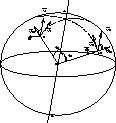 |
Figure 11:
Implementation of the convergent point method.  , , are the tangential velocities measured by Hipparcos for two
stars. are the tangential velocities measured by Hipparcos for two
stars.  , ,  , are deduced radial velocities assuming that
stars S1 and S2 belong to the same stream , are deduced radial velocities assuming that
stars S1 and S2 belong to the same stream |
The convergent point algorithm (see Fig. 11) follows the steps:
- 1.
- keep a pair of stars (S1,S2),
- 2.
- define vectors
 and
and  which are perpendicular
respectively to the plane (
which are perpendicular
respectively to the plane ( ,
, ) and
(
) and
( ,
, ),
),
- 3.
- obtain
 which is the direction of the
hypothetical convergent point A,
which is the direction of the
hypothetical convergent point A,
- 4.
- test the coherence of this direction with both tangential velocities: if
sgn(
 )
)  sgn(
sgn( ), it is not a convergent point. Go to 1,
), it is not a convergent point. Go to 1,
- 5.
- calculate angles between star directions and the convergent point:
 =(
=( ) and
) and
 =(
=( ),
),
- 6.
- infer moduli and signs of radial velocities:
|  |
|
| |
| (10) |
- 7.
- calculate space velocities V1 and V2 which vectors are strictly
parallels by construction
|  |
(11) |
- 8.
- test agreement between V1 and V2 within tolerance

 with fixed
with fixed  = 0.5 km s-1.
= 0.5 km s-1.
Following this process, a large number of may-be velocities are calculated. Several
definitions of each star velocity are obtained. All are distributed along a line in
the 3D velocity space, part of them being spurious. Real streams produce over-density
clumps formed by line intersections. The wavelet analysis detects such clumps in the
(U, V, W) distributions. The detection sensitivity is tested numerically by
simulating a variety of stream amplitudes and velocity dispersions over a velocity
ellipsoid background. Simulations show that our wavelet analysis implementation is able
to discriminate streams formed by at least 16 stars non-spatially localized and moving
together with a typical velocity dispersion of 2 km s-1 in a velocity
background matching the sample's one. The scale at which the stream velocity is
detected is a measure of the stream velocity dispersion. A more accurate knowledge of
this parameter is obtained after the full identification of the members
(see Sect. 5.3).
Velocities of open cluster stars are poorly reconstructed by this method because their
members are spatially close. For such stars, even a small internal velocity dispersion
results a poor determination of the convergent point. For this reason, we have
removed stars belonging to the 6 main identified space concentrations (Hyades OCl,
Coma Berenices OCl, Ursa Major OCl and Bootes 1, Pegasus 1, Pegasus 2 groups) found in
the previous spatial analysis. Eventually, the reconstruction of the velocity field is
performed with 2910 stars.
Reconstructed (U, V, W) distributions are given in an orthonormal frame centred
in the Sun velocity in the range [-50, 50] km s-1 on each component. The
wavelet analysis is performed on five scales: 3.2, 5.5, 8.6, 14.9 and
27.3 km s-1. In the following, the analysis focuses on the first three scales
revealing the stream-like structures because larger ones reach the typical size of the
velocity ellipsoid. Once the segmentation procedure is achieved, stars belonging to
velocity clumps are identify. The set of velocity definitions of a star may cross two
velocity clumps. In this case, the star is associated with the clump in which it
appears most frequently.
Despite the pre-selection of reconstructed velocities ( )some spurious velocities are still present in the field. For this reason, real velocity
clumps do include some proportion of spurious members generated by the convergent
point method. Estimating the proportion of spurious members in each velocity clump is
essential and is done by comparing the mean of reconstructed radial velocities of each
star with its observed radial velocity whenever this data is available (1362 among
2910 stars). For each star in a stream, the following procedure is adopted:
)some spurious velocities are still present in the field. For this reason, real velocity
clumps do include some proportion of spurious members generated by the convergent
point method. Estimating the proportion of spurious members in each velocity clump is
essential and is done by comparing the mean of reconstructed radial velocities of each
star with its observed radial velocity whenever this data is available (1362 among
2910 stars). For each star in a stream, the following procedure is adopted:
- 1.
- Only radial velocities reconstructed with other suspected members of the same stream are considered.
- 2.
- Mean
 and dispersion
and dispersion  of the reconstructed radial velocity distribution are calculated
(Fig. 12).
of the reconstructed radial velocity distribution are calculated
(Fig. 12).
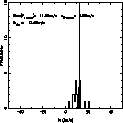 |
Figure 12:
Example of  distribution for one star suspected to be
member of a stream and its observed radial velocity (dot dashed line) distribution for one star suspected to be
member of a stream and its observed radial velocity (dot dashed line) |
- 3.
- The star is confirmed to belong to the stream when the normalized residual
doesn't exceed a value  . Residuals take into account errors
. Residuals take into account errors
 on the observed radial velocities given in the
Hipparcos Input Catalogue. These errors are classified into 4 main values: 0.5, 1.2,
2.5, 5 km s-1.
The threshold
on the observed radial velocities given in the
Hipparcos Input Catalogue. These errors are classified into 4 main values: 0.5, 1.2,
2.5, 5 km s-1.
The threshold  is fixed empirically on the basis of the normalized residual
histogram of all suspected stream members with observed radial velocities
(Fig. 13) at scale 2. It is set to
is fixed empirically on the basis of the normalized residual
histogram of all suspected stream members with observed radial velocities
(Fig. 13) at scale 2. It is set to  = 3 in order to
keep the bulk of the central peak. The results of this paper are robust to any
reasonable change of
= 3 in order to
keep the bulk of the central peak. The results of this paper are robust to any
reasonable change of  between 2.5 and 4.
between 2.5 and 4.
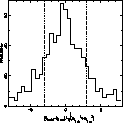 |
Figure 13:
Distribution of weighted radial velocity deviates (normalized residual) for
all suspected stream members with observed radial velocity at scale 2. Dashed line
delimits the area of high probability of false detection |
 |
Figure 14:
Proportion of rejected members for all the detected velocity clumps at
scale 2 by the selection on observed radial velocity function of the initial number of
members. Dashed line indicates the minimum number of stream members requires to detect
streams in simulations |





 Figure 15:
Hyades Scl. Thresholded wavelet coefficient isocontours at W=-2.4
km s-1 of the velocity field at scale 3 (top left) and scale 2 (top
right). This slice in wavelet coefficients at scale 2 reveals two of the three clumps
composing the whole supercluster. Age distributions of the whole group (stream 3-10 in
Table 2) at third scale (middle left) and of the first sub-stream
(stream 2-10 in Table 3) at second scale (middle right). Age
distributions of the two last sub-streams (stream 2-18 and 2-25 in Table
3) discovered at scale 2 (bottom)
Figure 15:
Hyades Scl. Thresholded wavelet coefficient isocontours at W=-2.4
km s-1 of the velocity field at scale 3 (top left) and scale 2 (top
right). This slice in wavelet coefficients at scale 2 reveals two of the three clumps
composing the whole supercluster. Age distributions of the whole group (stream 3-10 in
Table 2) at third scale (middle left) and of the first sub-stream
(stream 2-10 in Table 3) at second scale (middle right). Age
distributions of the two last sub-streams (stream 2-18 and 2-25 in Table
3) discovered at scale 2 (bottom)
Noise estimations in each velocity clump for the three first scales (provided that they
have at least 3 stars with observed VR), following the procedure quoted above,
are shown in Fig. 14. There are two regimes in these noise estimations:
streams with more than 50 initial suspected members ( ) which have a
contamination by spurious members around 30
) which have a
contamination by spurious members around 30 ; streams with less than 50 initial
suspected members which may have a contamination up to 85
; streams with less than 50 initial
suspected members which may have a contamination up to 85 . In this extreme case,
should we say that these streams are false detection? Not necessarily, because our
denoising method is too drastic towards small streams. Indeed, in those, each star has
very few reconstructions of its radial velocity with the other members of the
. In this extreme case,
should we say that these streams are false detection? Not necessarily, because our
denoising method is too drastic towards small streams. Indeed, in those, each star has
very few reconstructions of its radial velocity with the other members of the
same
stream. The dispersion of the reconstructed  distribution is necessarily
small, implying an important normalized residual. Then, the star is often rejected. If
we refer to our previous simulations there is a high probability that under 16 initial
members, streams are false detection.
distribution is necessarily
small, implying an important normalized residual. Then, the star is often rejected. If
we refer to our previous simulations there is a high probability that under 16 initial
members, streams are false detection.
At the end of this selection we obtain the number of confirmed members among stars with
observed VR in each stream for the three first scales (column  in
Tables 2, 3 and 4) and their sum (line
Total 2 in column
in
Tables 2, 3 and 4) and their sum (line
Total 2 in column  ).
).
Table 2:
Main characteristics of detected streams at scale 3 with filter size of 8.6
km s-1 ( 6.3 km s-1).
6.3 km s-1).
 ,
,  and
and  are the mean velocity components and their dispersions calculated,
after selection on
are the mean velocity components and their dispersions calculated,
after selection on  , with the true radial velocity data -
, with the true radial velocity data -
 is the initial number of stars belonging to the structure -
is the initial number of stars belonging to the structure -
 is the number of stars with observed radial velocity -
is the number of stars with observed radial velocity -
 is the number of stars among
is the number of stars among  after selection 5.2.1. The
selection has not been done in case where there is less than 3 observed radial
velocities. In this last case an d also when none of the stars are selected we do not
present the line in the table. However the same stream identifiers are conserved: the
first digit is the scale followed by the stream number. Column
after selection 5.2.1. The
selection has not been done in case where there is less than 3 observed radial
velocities. In this last case an d also when none of the stars are selected we do not
present the line in the table. However the same stream identifiers are conserved: the
first digit is the scale followed by the stream number. Column  is the percentage of field st ars estimated in each structure with the procedure 5.2.2.
Cross-identification is done with Eggen's superclusters (SCl) and open cluster (OCl)
data from Paloùs and Eggen (in Gomez et al. 1990) (see
Table 5) - Total 1 gives the s um of suspected stream members (Col.
is the percentage of field st ars estimated in each structure with the procedure 5.2.2.
Cross-identification is done with Eggen's superclusters (SCl) and open cluster (OCl)
data from Paloùs and Eggen (in Gomez et al. 1990) (see
Table 5) - Total 1 gives the s um of suspected stream members (Col.
 ) and the sum of observed VR among them (Col.
) and the sum of observed VR among them (Col.  ) -
Total 2 gives the sum of all confirmed stream stars among available observed
radial velocities (Col.
) -
Total 2 gives the sum of all confirmed stream stars among available observed
radial velocities (Col.  ) - Total 3 is the sum of all expected
stream members in each stream (Col.
) - Total 3 is the sum of all expected
stream members in each stream (Col.  ) taking into account the
confirmed/suspected ratio obtained in each stream - Total 4 gives the inferred
fraction of stars in stream in the full sample of 2910 stars (Col.
) taking into account the
confirmed/suspected ratio obtained in each stream - Total 4 gives the inferred
fraction of stars in stream in the full sample of 2910 stars (Col.  ).
Total 5 is the fraction of stars in stream corrected for field contamination
(Col.
).
Total 5 is the fraction of stars in stream corrected for field contamination
(Col.  )
)
![\begin{tabular}[h]
{lrrrrr@{$~\pm~$}lr@{$~\pm~$}lr@{$~\pm~$}l}
\hline \\ Stream ...
...f stars in streams
corrected for field contamination)}\\ \hline \\ \end{tabular}](/articles/aas/full/1999/04/ds1599/img105.gif) |
Table 3:
Main characteristics of detected velocity structures at scale 2 with
filter size of 5.5 km s-1 ( 3.8
km s-1). Legend is the same as Table 2
3.8
km s-1). Legend is the same as Table 2
![\begin{tabular}[h]
{lrrrr@{$~\pm~$}lr@{$~\pm~$}lr@{$~\pm~$}l}
\hline \\ Stream &...
...& & \multicolumn{6}{l}{(Fraction of stars in streams)}\\ \hline \\ \end{tabular}](/articles/aas/full/1999/04/ds1599/img106.gif) |
Table 4:
Main characteristics of detected velocity structures at scale 1 with typical
size of 3.2 km s-1 ( 2.4 km s-1). Legend
is the same as Table 2
2.4 km s-1). Legend
is the same as Table 2
![\begin{tabular}[h]
{lrrrr@{$~\pm~$}lr@{$~\pm~$}lr@{$~\pm~$}l}
\hline \\ Stream &...
... & \multicolumn{6}{l}{(Fraction of stars in streams)}\\ \hline \\ \end{tabular}](/articles/aas/full/1999/04/ds1599/img107.gif) |
Table 5:
Cross-identification data for known kinematical groups: Open clusters (OCl)
and Superclusters (SCl)
![\begin{tabular}[h]
{lrrrcl}
\hline \\ & $\overline{U}$\space & $\overline{V}$\sp...
...ace \& $1.2~10^{9}$\space &
\cite[Eggen, 1996]{Egg96}\\ \hline \\ \end{tabular}](/articles/aas/full/1999/04/ds1599/img108.gif) |
The fraction of a smooth distribution filling the velocity ellipsoid of our complete
sample, expected inside the velocity volume spanned by the 6 superclusters
described bellow, range between 2 and 4
and 4 depending on the position of the
structure with respect to the distribution centroid. Adding up these contributions,
19.2
depending on the position of the
structure with respect to the distribution centroid. Adding up these contributions,
19.2 of field stars should be expected to fill the total volume occupied by
superclusters with pure random coincidence. This is about
of field stars should be expected to fill the total volume occupied by
superclusters with pure random coincidence. This is about  of the stars
detected as supercluster members at scale 3. However, streams with smaller
velocity dispersions (scales 1 and 2) are not significantly affected by this
background. Proportions of field stars for the largest structures found at scale 3 are
given in 2 at column
of the stars
detected as supercluster members at scale 3. However, streams with smaller
velocity dispersions (scales 1 and 2) are not significantly affected by this
background. Proportions of field stars for the largest structures found at scale 3 are
given in 2 at column  while it is neglected for the
remaining streams.
Tables 2, 3 and 4 give mean velocities,
velocity dispersions and numbers of stars remaining after correction of spurious
members (procedure 5.2.1) and field stars (procedure
5.2.2) for streams at respectively scale 3, 2 and 1. Each stream has
while it is neglected for the
remaining streams.
Tables 2, 3 and 4 give mean velocities,
velocity dispersions and numbers of stars remaining after correction of spurious
members (procedure 5.2.1) and field stars (procedure
5.2.2) for streams at respectively scale 3, 2 and 1. Each stream has
 observed radial velocity members. Out of the
observed radial velocity members. Out of the  stars with
radial velocities among suspected stream members, only
stars with
radial velocities among suspected stream members, only  get confirmed by
procedure 5.2.1. So the ratio
get confirmed by
procedure 5.2.1. So the ratio  /
/ is an
estimate of the confirmed/suspected ratio in each stream. Applying this ratio to
is an
estimate of the confirmed/suspected ratio in each stream. Applying this ratio to
 (total stream member candidates) we get the expected number of real
stream members in each stream, and the total number of stream members in the sample
(Total 3). The percentage of stars in streams in the total sample follows (
Total 4). The correction for the uniform background contribution is negligible at
scales 1 and 2; it is significant at scale 3 where the fraction of stars in streams
drops from 63.0
(total stream member candidates) we get the expected number of real
stream members in each stream, and the total number of stream members in the sample
(Total 3). The percentage of stars in streams in the total sample follows (
Total 4). The correction for the uniform background contribution is negligible at
scales 1 and 2; it is significant at scale 3 where the fraction of stars in streams
drops from 63.0 to 46.4
to 46.4 . In the case of large velocity dispersion structures
at scale 3 proportions of field stars is also given in column
. In the case of large velocity dispersion structures
at scale 3 proportions of field stars is also given in column  and the percentage of remaining stream stars is done in column
and the percentage of remaining stream stars is done in column  line
Total 5.
line
Total 5.
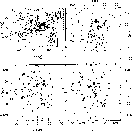 |
Figure 16:
Space distribution of Hyades SCl from the  selected
sub-sample at scale 3 (stream 3-10 in Table 2) selected
sub-sample at scale 3 (stream 3-10 in Table 2) |






Figure 17:
Sirius Scl. Thresholded wavelet coefficient isocontours at
W=-10.1 km s-1 of the velocity field at scale 3 (top left) and scale 2
(top right). At scale 2, Sirius SCl is composed of 2 main streams (stream 2-37
and 2-41 in Table 3). The 2 is shown on this W slice of wavelet
coefficients. Age distributions of the whole Sirius SCl at third scale (middle
left) and stream 2-37 at second scale (middle right). Age distribution s of
stream 2-41 at scale 2 (bottom left) and stream 1-56 (in Table 4)
at scale 1 (bottom right). This latest figure (highest resolution) shows that
separating oldest populations is out of reach
Streams appearing at scale 3 ( is shown on this W slice of wavelet
coefficients. Age distributions of the whole Sirius SCl at third scale (middle
left) and stream 2-37 at second scale (middle right). Age distribution s of
stream 2-41 at scale 2 (bottom left) and stream 1-56 (in Table 4)
at scale 1 (bottom right). This latest figure (highest resolution) shows that
separating oldest populations is out of reach
Streams appearing at scale 3 ( 6.3
km s-1) correspond to the so-called Eggen superclusters. Four already known
such structures are found: the Pleiades, Hyades and Sirius superclusters
(hereafter SCl) and the whole Centaurus association. Moreover, evidence is given for
one additional structure not detected yet. The reason why this supercluster
remained undetected is probably the small velocity offset with respect to the Sun's. At
smaller scales ( 6.3
km s-1) correspond to the so-called Eggen superclusters. Four already known
such structures are found: the Pleiades, Hyades and Sirius superclusters
(hereafter SCl) and the whole Centaurus association. Moreover, evidence is given for
one additional structure not detected yet. The reason why this supercluster
remained undetected is probably the small velocity offset with respect to the Sun's. At
smaller scales ( 3.8 and 2.4 km s-1)
superclusters split into distinct streams of smaller velocity dispersions. 3.8 and 2.4 km s-1)
superclusters split into distinct streams of smaller velocity dispersions.
The analysis of the age distribution inside each stream is performed on three different
data sets:
- the whole sample (ages are either Strömgren or palliative),
- the sample restricted to stars with Strömgren photometry data (without
selection on radial velocity),
- the sample restricted to stars with observed (as opposed to
reconstructed) radial velocity data (ages are either Strömgren or palliative).
The selection on photometric ages gives a more accurate description of the stream age
content while the last sample permits to obtain a reliable kinematic description since
stream members are selected through the 5.2.1 procedure. All mean
velocities and velocity dispersions of the streams are calculated with the radial
velocity data set. Combining results from these selected data sets generally brings
unambiguous conclusions.
- 1.
- Pleiades SCl
The analysis of the Pleiades SCl is realized in Paper II where it is found to be
composed of two main streams of few 107 and 109 yr.
- 2.
- Hyades SCl and NGC 1901 stream
The velocity clump (stream 3-10 in Table 2) identified at scale 3 as the
Hyades SCl (see Figs. 15 for velocity and age distributions and
Figs. 16 for space distributions) is located at
(U, V, W)=(-32.9, -14.5, -5.6) km s-1 with velocity dispersions
( , ,  , ,  )=(6.6, 6.8, 6.5) km s-1. The mean
velocity deviates slightly from the definition given by
Eggen (1992b)
(cf. Table 5).
At this resolution the
bulk of star ages is between 4 108 yr and 2 109 yr with two peaks at
6 108 and 1.6 109 yr in Strömgren age distribution plus a 107 yr
peak in the palliative age distribution.
Eggen (1992b)
pointed out that the supercluster contains at
least three age groups around 3 to 4, 6 and 8 108 yr.
The velocity pattern splits into 3 groups at scale 2, namely 2-10, 2-18 and 2-25
(Table 3). Each stream presents a characteristic age distribution, although
the velocity separation (centers deviates from each other by several km s-1 in W)
does not produce a neat age separation. Three different main components of 107,
5 - 6 108 and 109 yr are mixed in the 3 clumps. The first clump peaks at
109 yr in Strömgren ages but contains a 6 108 yr old component also
revealed by palliative ages. The second clump peaks at 5 108 yr and 109 yr
in Strömgren ages. Palliative ages produce a 107 yr peak which is probably a
statistical ghost of the 5 108 year old component (see explanation of ghost at
the end of Sect. 3.2). The third clump is dominated by a 5 108 yr
old component with two older groups of 109 and 2 109 yr. One more time the
very young peak in palliative ages is also probably due to the 5 108 year old
component. )=(6.6, 6.8, 6.5) km s-1. The mean
velocity deviates slightly from the definition given by
Eggen (1992b)
(cf. Table 5).
At this resolution the
bulk of star ages is between 4 108 yr and 2 109 yr with two peaks at
6 108 and 1.6 109 yr in Strömgren age distribution plus a 107 yr
peak in the palliative age distribution.
Eggen (1992b)
pointed out that the supercluster contains at
least three age groups around 3 to 4, 6 and 8 108 yr.
The velocity pattern splits into 3 groups at scale 2, namely 2-10, 2-18 and 2-25
(Table 3). Each stream presents a characteristic age distribution, although
the velocity separation (centers deviates from each other by several km s-1 in W)
does not produce a neat age separation. Three different main components of 107,
5 - 6 108 and 109 yr are mixed in the 3 clumps. The first clump peaks at
109 yr in Strömgren ages but contains a 6 108 yr old component also
revealed by palliative ages. The second clump peaks at 5 108 yr and 109 yr
in Strömgren ages. Palliative ages produce a 107 yr peak which is probably a
statistical ghost of the 5 108 year old component (see explanation of ghost at
the end of Sect. 3.2). The third clump is dominated by a 5 108 yr
old component with two older groups of 109 and 2 109 yr. One more time the
very young peak in palliative ages is also probably due to the 5 108 year old
component.
The presence of older supercluster members around 1.6 109 yr as
stipulated by Eggen and stressed by
Chen et al. (1997)
is detected in the third velocity clump. Scale 1 does not reveal
more information so that we cannot obtain one age for each stream.
So, the Hyades SCl contains probably three groups of 5-6 108 yr, 109
and 1.6-2 109 yr which are in an advanced stage of dispersion in the same
velocity volume. Only part of these 3 streams can be linked to the evaporation of
known open clusters. The Hyades OCl recent evaporation is clearly found separately in
stream 2-15. The Praesepe OCl mean velocity (Table 5) accurately match
none of the 3 stream velocities but could explain the stream 2-18 despite a difference
of
 9 km s-1 in the V component. The NGC 1901 supercluster
described in
Eggen, 1996
and assumed to be a Hyades SCl component is found separately
at scale 2 (stream 2-29 in Table 3) and exhibits a single mode in age
distribution at 8 108 yr. Its velocity is more dissociated from the
supercluster mean velocity than the 3 other streams which explain a best member
extraction. 9 km s-1 in the V component. The NGC 1901 supercluster
described in
Eggen, 1996
and assumed to be a Hyades SCl component is found separately
at scale 2 (stream 2-29 in Table 3) and exhibits a single mode in age
distribution at 8 108 yr. Its velocity is more dissociated from the
supercluster mean velocity than the 3 other streams which explain a best member
extraction.
- 3.
- Sirius SCl
The Sirius supercluster (see Figs. 17 for velocity and age
distributions and Figs. 18, 19 for space
distributions) is found on scale 3 (stream 3-19 in Table 4) at mean
velocity (U, V, W)=(+14.0, +1.0, -7.8) km s-1 with velocity dispersions
( , ,  , ,  ) = (7.3, 6.4, 5.5) km s-1.
Eggen (1992c) identifies two age groups, 6.3 108 and 109
yr and notices that there are also younger (2.5 108 yr) and older members
(1.5
109 yr). At the coarse resolution (scale 3), the age distribution
is in relative good agreement with this description: Strömgren ages peak at
6 108 yr and there is a significant proportion of stars between 109 and
2
109 yr. Stars younger than 2.5 108 yr are probably not a
statistical ghost of the 6 108 year old component since some stars with
Strömgren ages are also present. ) = (7.3, 6.4, 5.5) km s-1.
Eggen (1992c) identifies two age groups, 6.3 108 and 109
yr and notices that there are also younger (2.5 108 yr) and older members
(1.5
109 yr). At the coarse resolution (scale 3), the age distribution
is in relative good agreement with this description: Strömgren ages peak at
6 108 yr and there is a significant proportion of stars between 109 and
2
109 yr. Stars younger than 2.5 108 yr are probably not a
statistical ghost of the 6 108 year old component since some stars with
Strömgren ages are also present.
At scale 2, the supercluster splits into two distinct streams
(stream 2-37 and 2-41 in Table 3) at respectively (U, V, W) = (+12.4,
+0.7, -7.7) km s-1 with ( , ,  , ,  ) = (4.0, 4.6,
4.7) km s-1 and (U, V, W) = (+12.4, +4.2, -9.0) km s-1 with
( ) = (4.0, 4.6,
4.7) km s-1 and (U, V, W) = (+12.4, +4.2, -9.0) km s-1 with
( , ,  , ,  ) = (3.7, 3.3, 2.9) km s-1 producing a
very clear age separation: the very young stars are separated from a part of the
oldest components (6 108 and 1.6 109 yr). The very young component appears
exclusively in stream 2-37 (middle right of Fig. 17). At the highest
resolution, on scale 1 (bottom of Fig. 17), the stream 2-41 contains
oldest components still interpenetrated. Space distributions
(Fig. 19) show that the first stream, which contains the
107 year old component is still concentrated. There are too few members in the
second clump to make conclusions. ) = (3.7, 3.3, 2.9) km s-1 producing a
very clear age separation: the very young stars are separated from a part of the
oldest components (6 108 and 1.6 109 yr). The very young component appears
exclusively in stream 2-37 (middle right of Fig. 17). At the highest
resolution, on scale 1 (bottom of Fig. 17), the stream 2-41 contains
oldest components still interpenetrated. Space distributions
(Fig. 19) show that the first stream, which contains the
107 year old component is still concentrated. There are too few members in the
second clump to make conclusions.
The Sirius SCl is composed by three age components of  , 6 108
and 1.5 109. The younger stream is still concentrated both kinematically and
spatially while the two oldest streams are mixed in a larger volume of the phase
space. , 6 108
and 1.5 109. The younger stream is still concentrated both kinematically and
spatially while the two oldest streams are mixed in a larger volume of the phase
space.
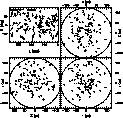 |
Figure 18:
Space distribution of Sirius SCl from the VR selected
sub-sample at scale 3 (stream 3-19 in Table 2) |
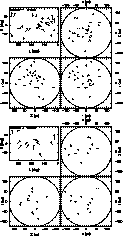 |
Figure 19:
Space distributions of the 2 sub-streams of Sirius SCl from the VR
selected sub-sample at scale 2: stream 2-37 (top) and 2-41 in Table 3
(bottom) |
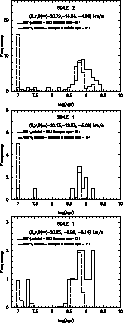 |
Figure 20:
IC 2391 SCl. Age distributions for the IC 2391 SCl (stream 2-14 in
Table 3) at scale 2 (top), for sub-stream 1-20 (in Table 4) at
scale 1 (middle) and for sub-stream 1-25 (in Table 4) at scale 1
(bottom) |
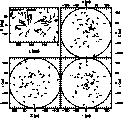 |
Figure 21:
Space distribution of IC 2391 SCl from the VR selected sub-sample
at scale 2 (stream 2-14 in Table 3) |
- 4.
- IC 2391 SCl
The IC 2391 SCl (see Figs. 20 for age distributions and
Fig. 21 for space distributions) is not found at large scale
because it may have been merged into the Centaurus association velocity group. It
appears separately at scale 2 (stream 2-14 in Table 3) at
(U, V, W) = (-20.8, -14.5, -4.9) km s-1 with velocity dispersions
( , ,  , ,  ) = (4.3, 4.9, 5.0) km s-1 (see
Fig. 15 of Paper II). Eggen (1991) states that IC 2391 SCl contains
two ages: 8 107 and 2.5 108 yr while
Chen et al. (1997)
found a mean age of ) = (4.3, 4.9, 5.0) km s-1 (see
Fig. 15 of Paper II). Eggen (1991) states that IC 2391 SCl contains
two ages: 8 107 and 2.5 108 yr while
Chen et al. (1997)
found a mean age of  1.6
108 yr. The
Strömgren age distribution is quite different from the palliative age distribution
at coarser resolution. Strömgren ages peak at 8 108 but with ages up to
2 109 yr. Palliative ages exhibit a peak at 6 108 yr and a
107 year old component (Fig. 20). This last peak is certainly
real because its proportion is too high to be a statistical ghost of palliative ages
from a 6 108 year old component and moreover Strömgren ages show the
presence of young stars. Two sub-streams are found at scale 1 (stream 1-20 and 1-25 in
Table 4) at (U, V, W) = (-20.1, -12.8, -5.0) with
( 1.6
108 yr. The
Strömgren age distribution is quite different from the palliative age distribution
at coarser resolution. Strömgren ages peak at 8 108 but with ages up to
2 109 yr. Palliative ages exhibit a peak at 6 108 yr and a
107 year old component (Fig. 20). This last peak is certainly
real because its proportion is too high to be a statistical ghost of palliative ages
from a 6 108 year old component and moreover Strömgren ages show the
presence of young stars. Two sub-streams are found at scale 1 (stream 1-20 and 1-25 in
Table 4) at (U, V, W) = (-20.1, -12.8, -5.0) with
( , ,  , ,  (2.9, 3.1, 1.8) km s-1
and (U, V, W) = (-20.9, -10.0, -6.1) with
(
(2.9, 3.1, 1.8) km s-1
and (U, V, W) = (-20.9, -10.0, -6.1) with
( , ,  , ,  ) = (4.5, 3.7, 2.9) km s-1. The
stream 1-20 contains all the youngest stars while the sub-stream 1-25 is only
constituted of the 6 108 year old population. Velocity dispersions of the
two streams are in agreement with this view: they are smaller for the stream with the
younger component. This configuration is exactly the opposite of the Pleiades' one: in
this case the youngest population is more concentrated in the velocity space and is
entirely detected in one stream while the oldest span over the two streams. ) = (4.5, 3.7, 2.9) km s-1. The
stream 1-20 contains all the youngest stars while the sub-stream 1-25 is only
constituted of the 6 108 year old population. Velocity dispersions of the
two streams are in agreement with this view: they are smaller for the stream with the
younger component. This configuration is exactly the opposite of the Pleiades' one: in
this case the youngest population is more concentrated in the velocity space and is
entirely detected in one stream while the oldest span over the two streams.
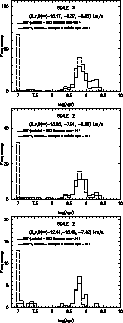 |
Figure 22:
Streams associated with Centaurus Associations. Age distributions of the
overall association (stream 3-15 in Table 2) at scale 3 (top). Age
distributions of Centaurus-Crux (stream 2-26 in Table 3) at scale 2
(middle). Age distributions of Centaurus-Lupus (stream 2-12 in
Table 3) at scale 2 (bottom) |
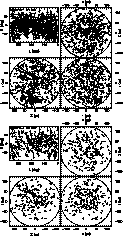 |
Figure 23:
Space distributions of the stream associated with Centaurus Associations
(stream 3-15 in Table 2) for all the stars (top) and for the
VR selected sub-sample (bottom) at scale 3. Stars belonging to spatial
clumps in the upper figure disappear because of the lack of observed radial
velocities |
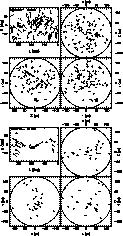 |
Figure 24:
Space distributions of sub-streams associated with Centaurus
Associations. Centaurus-Crux (stream 2-26 in Table 3) (top) and
Centaurus-Lupus (stream 2-12 in Table 3) (bottom) associations
from the VR selected sub-sample at scale 2. A disklike structure appears with the
Centaurus-Lupus stream, on the (X, Z) projection, reflecting the Gould
Belt |
- 5.
- Centaurus Associations and the Gould belt
Lower Centaurus-Crux and upper Centaurus-Lupus associations
(see Figs. 22 for age distributions and Figs. 23
for space distributions) which are the main components of the entire Centaurus
association are detected as one velocity clump at scale 3 (stream 3-15 in
Table 2) with (U, V, W) = (-15.2, -8.4, -8.8) km s-1
with velocity dispersion ( , ,  , ,  ) = (8.6, 6.7, 6.1)
km s-1. Scale 3 is a too coarse resolution and the age distributions reflect the
overall distribution. The whole Centaurus association is splitted into two parts at
scale 2 and does not evolve at scale 1 (see Paper II, Fig. 15). ) = (8.6, 6.7, 6.1)
km s-1. Scale 3 is a too coarse resolution and the age distributions reflect the
overall distribution. The whole Centaurus association is splitted into two parts at
scale 2 and does not evolve at scale 1 (see Paper II, Fig. 15).
At scale 2, Centaurus-Crux (stream 2-26 in Table 3) and
Centaurus-Lupus (stream 2-12 in Table 3) are identified at (U, V, W) =
(-13.1, -7.9, -9.3) km s-1 with ( , ,  , ,  )= (6.2, 6.1, 5.5) km s-1 and (U, V, W) = (-12.4, -16.5, -7.4)
km s-1 with ( )= (6.2, 6.1, 5.5) km s-1 and (U, V, W) = (-12.4, -16.5, -7.4)
km s-1 with ( , ,  , ,  ) = (6.1, 4.6, 3.1)
km s-1 respectively. Unfortunately, as for the Pleiades SCl, a lot of young stars
have not Strömgren photometry. Strömgren age distributions peak at 6 108 yr
for both sub-streams but palliative age distributions show the predominance of the
very young population (107 yr) in each case. ) = (6.1, 4.6, 3.1)
km s-1 respectively. Unfortunately, as for the Pleiades SCl, a lot of young stars
have not Strömgren photometry. Strömgren age distributions peak at 6 108 yr
for both sub-streams but palliative age distributions show the predominance of the
very young population (107 yr) in each case.
There is a crucial lack of radial velocities for the spatially clustered
structures Centaurus-Crux and Centaurus-Lupus: one fifth of stars have observed
VR. That is why these space clumps are visible on space distributions when taking
into account all the stars of the detected streams but disappear with the sub-sample
selected on observed VR (Fig. 23). At scale 2, space
distributions show that stars of the velocity substructure identified as
Centaurus-Lupus association belong to a disk-like structure (see XZ projection in
Fig. 24) tilted with respect to the Galactic disk.
Eigenvectors of the spatial ellipsoid are calculated. The two vectors associated with
the largest eigenvalues allow to define the plane of the structure, assuming it passes
through the Sun. The ascending node of the intersection between this disk-like
structure and the Galactic plane is  which differs slightly
from usual values ( which differs slightly
from usual values ( to to  ,
Pöppel 1997).
The angle between the two planes is ,
Pöppel 1997).
The angle between the two planes is  in agreement with previous study
( in agreement with previous study
( ). ).





 Figure 25:
New supercluster
Figure 25:
New supercluster. Age distributions of the new moving group (stream 3-18
in Table 3) at scale 3 ( top left) and the sub-stream 2-27 (in
Table 3) at scale 2 ( top right). Age distributions o f the
sub-streams 2-35 ( middle left) and 2-38 ( middle right) at scale 2. Age
distributions of the sub-streams 2-43 ( bottom left) and 2-44 ( bottom right)
at scale 2
- 6.
- A new supercluster
Close to the Sirius SCl in velocity space, located at the mean velocity
(U, V, W) = (+3.6, +2.9, -6.0) km s-1 with velocity dispersions
( , ,  , ,  ) = (6.8, 5.0, 6.3) km s-1, a new
massive supercluster (stream 3-18 in Table 2) is detected at scale
3 (see Figs. 25 for age distributions and
Fig. 26 for spatial distribution). It contains almost twice as many
members as the Sirius SCl. None of the previously known superclusters corresponds
to this velocity definition. Figueras et al. (1997)
indicate the presence of a velocity
structure at (U, V) = (+7, +6) which they cannot confirm without doubt by their
analysis and interpreted it as a possible sub-structure of Sirius SCl with a mean age
of 109 yr. We confirm the existence of a supercluster like structure,
probably never detected before because of its low velocity with respect to the Sun. On
a kinematics basis it is clearly dissociated from the Sirius SCl. ) = (6.8, 5.0, 6.3) km s-1, a new
massive supercluster (stream 3-18 in Table 2) is detected at scale
3 (see Figs. 25 for age distributions and
Fig. 26 for spatial distribution). It contains almost twice as many
members as the Sirius SCl. None of the previously known superclusters corresponds
to this velocity definition. Figueras et al. (1997)
indicate the presence of a velocity
structure at (U, V) = (+7, +6) which they cannot confirm without doubt by their
analysis and interpreted it as a possible sub-structure of Sirius SCl with a mean age
of 109 yr. We confirm the existence of a supercluster like structure,
probably never detected before because of its low velocity with respect to the Sun. On
a kinematics basis it is clearly dissociated from the Sirius SCl.
Age distributions at coarser scale are similar to the whole sample ones with ages
ranging from 107 to 2.5 109 yr. But at least 5 sub-streams at scale 2
(see Table 3) are found to form this structure. These streams show age
distributions of relatively old components. Stream 2-27 shows an unambiguous peak at
6 108 yr with few 1.6 109 year old stars. On the basis of velocity
and age content, this stream could originate from the evaporation of the Coma OCl.
Stream 2-35 has stars which are 6 108, 109 and 1.6 109 year
old on the basis of Strömgren photometry but palliative ages exhibit only one peak
at 6 108 yr. Stream 2-38 shows a peak at 5 108 yr. Stream 2-43 has
Strömgren ages between 6-8 108 and few 1.6 109 year old stars
but the palliative ages exhibit only one peak at 8 108. Stream 2-44 is
clearly a 109 year old group. All the few very young palliative ages in each
stream are probably statistical ghost because very young Strömgren ages are never
present.
Age distributions at the highest resolution (scale 1), not shown here, give exactly the
same results as scale 2 but the number of stars dramatically decreases.
This structure has the same features as the previously known
superclusters: a juxtaposition of several little star formation bursts at different
epochs in adjacent cells of the velocity field. The correlation between velocity and
age is not always obvious because these bursts (5-6 108, 8 108 and 109
yr) are not very recent. As in the Hyades SCl case, stream velocity volumes, defined by
their velocity dispersions, are substantially recovering.
Implications of these results on the understanding of the supercluster concept
are discussed in Paper II.
- Small scale streams.
While superclusters are found to split into smaller scale streams most of them
corresponding to well defined age, a number of other streams are detected only at
small scales. Stream 2-13 in Table 3 (Fig. 27) is
a typical example of such a stream. Its age distribution shows a mono-age component of
109 year old and its vertical velocity is high (W=-15.3 km s-1). Space
distribution does not fill the 125 pc radius sphere and Fig. 27
probably shows on (X, Z) and (Y, Z) projections the orbit tube in which stars
are confined. Stream 2-7 in Table 3 shows also the same features with a
6 108 year old component and a lower vertical velocity
(W= -8.5 km s-1).
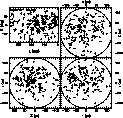 |
Figure 26:
Space distributions of New SCl (stream 3-18 in Table 2)
from the V R selected sub-sample at scale 3 |
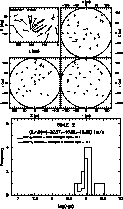 |
Figure 27:
Stream 2-13 (in Table 3). Space (top) and age
(bottom) distributions from the sub-set without V R selection at scale
2 |
- Particulars on oldest groups.
Another striking feature of the velocity field is the existence of a 2 109
year old population still in velocity structures. These streams are only detected at
the coarser resolution (scale 3) in agreement with an intrinsically large velocity
dispersion. They have much less members (between 20 and 30 initial members) than the
previously investigated streams and have very few observed V R. Two main old
groups (stream 3-9 and 3-14 in Table 2 and
Figs. 28, 29)
are clearly detected and have
similar characteristics:
- Age distributions peak between 1.6 and 2 109 yr.
- Their velocity dispersion obtained from the few selected stars on observed
VR are of order 6 km s-1 (stream 3-14 seems to have a lower
velocity dispersion but the result is obtained for only 3 stars).
- U-component is positive (towards the galactic center) and often larger than 20
km s-1.
- Space distributions may still be clumpy.
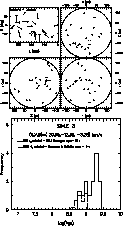 |
Figure 28:
Stream 3-9 (in Table 2). Space (top) and age (
bottom) distributions from the sub-set without V R selection at scale
3 |
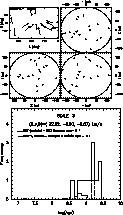 |
Figure 29:
Stream 3-14 (in Table 2).
Space (top) and age (
bottom) distributions from the sub-set
without VR selection at scale 3 |
We should notice at this point that these old star streams are both affected by two
biases with respect to the whole sample characteristics. They have much less observed
radial velocities (16 vs. 46 vs. 46 ) and have much more Strömgren photometry
(57 ) and have much more Strömgren photometry
(57 vs. 37 vs. 37 ). For this reason, space distributions are displayed without radial
velocity selection. ). For this reason, space distributions are displayed without radial
velocity selection.
Streams are rather fragile structures originating from cluster evaporation. The
survival of these relatively old moving groups with coherent ages can be explain by
two non exclusive mechanisms. On one hand, recent simulations
(Zwart et al. 1998)
of heavy cluster dynamical evolution
(with  32000 particles) have shown that contrary to lighter open clusters whose
typical lifetime is 1-2 108
(Wielen 1971
and
Lyngå 1982), heavy
clusters can survive up to 4 Gyr in the Galactic gravitational field. This long
lifetime can authorize to maintain old streams but such heavy open clusters are
probably very rare in the disc. On the other hand, as sketched in
Dehnen (1998)
to explain their eccentric orbits, stars of these moving
groups, provided that they were formed in the inner part of the disc, could have been
trapped into resonant orbits with the non-axisymmetric force created by the
gravitational potential of the Galactic bar. This latest explanation does not require
any minimum lifetime to the initially bound structure from which streams originate. 32000 particles) have shown that contrary to lighter open clusters whose
typical lifetime is 1-2 108
(Wielen 1971
and
Lyngå 1982), heavy
clusters can survive up to 4 Gyr in the Galactic gravitational field. This long
lifetime can authorize to maintain old streams but such heavy open clusters are
probably very rare in the disc. On the other hand, as sketched in
Dehnen (1998)
to explain their eccentric orbits, stars of these moving
groups, provided that they were formed in the inner part of the disc, could have been
trapped into resonant orbits with the non-axisymmetric force created by the
gravitational potential of the Galactic bar. This latest explanation does not require
any minimum lifetime to the initially bound structure from which streams originate.


Up: The distribution of nearby Hipparcos
Copyright The European Southern Observatory (ESO)
| 


![]() distribution is necessarily
small, implying an important normalized residual. Then, the star is often rejected. If
we refer to our previous simulations there is a high probability that under 16 initial
members, streams are false detection.
distribution is necessarily
small, implying an important normalized residual. Then, the star is often rejected. If
we refer to our previous simulations there is a high probability that under 16 initial
members, streams are false detection.
![]() in
Tables 2, 3 and 4) and their sum (line
Total 2 in column
in
Tables 2, 3 and 4) and their sum (line
Total 2 in column ![]() ).
).
![\begin{tabular}[h]
{lrrrrr@{$~\pm~$}lr@{$~\pm~$}lr@{$~\pm~$}l}
\hline \\ Stream ...
...f stars in streams
corrected for field contamination)}\\ \hline \\ \end{tabular}](/articles/aas/full/1999/04/ds1599/img105.gif)
![\begin{tabular}[h]
{lrrrr@{$~\pm~$}lr@{$~\pm~$}lr@{$~\pm~$}l}
\hline \\ Stream &...
...& & \multicolumn{6}{l}{(Fraction of stars in streams)}\\ \hline \\ \end{tabular}](/articles/aas/full/1999/04/ds1599/img106.gif)
![\begin{tabular}[h]
{lrrrr@{$~\pm~$}lr@{$~\pm~$}lr@{$~\pm~$}l}
\hline \\ Stream &...
... & \multicolumn{6}{l}{(Fraction of stars in streams)}\\ \hline \\ \end{tabular}](/articles/aas/full/1999/04/ds1599/img107.gif)
![\begin{tabular}[h]
{lrrrcl}
\hline \\ & $\overline{U}$\space & $\overline{V}$\sp...
...ace \& $1.2~10^{9}$\space &
\cite[Eggen, 1996]{Egg96}\\ \hline \\ \end{tabular}](/articles/aas/full/1999/04/ds1599/img108.gif)

![]() 9 km s-1 in the V component. The NGC 1901 supercluster
described in
Eggen, 1996
and assumed to be a Hyades SCl component is found separately
at scale 2 (stream 2-29 in Table 3) and exhibits a single mode in age
distribution at 8 108 yr. Its velocity is more dissociated from the
supercluster mean velocity than the 3 other streams which explain a best member
extraction.
9 km s-1 in the V component. The NGC 1901 supercluster
described in
Eggen, 1996
and assumed to be a Hyades SCl component is found separately
at scale 2 (stream 2-29 in Table 3) and exhibits a single mode in age
distribution at 8 108 yr. Its velocity is more dissociated from the
supercluster mean velocity than the 3 other streams which explain a best member
extraction.
![]() ,
, ![]() ,
, ![]() ) = (4.0, 4.6,
4.7) km s-1 and (U, V, W) = (+12.4, +4.2, -9.0) km s-1 with
(
) = (4.0, 4.6,
4.7) km s-1 and (U, V, W) = (+12.4, +4.2, -9.0) km s-1 with
(![]() ,
, ![]() ,
, ![]() ) = (3.7, 3.3, 2.9) km s-1 producing a
very clear age separation: the very young stars are separated from a part of the
oldest components (6 108 and 1.6 109 yr). The very young component appears
exclusively in stream 2-37 (middle right of Fig. 17). At the highest
resolution, on scale 1 (bottom of Fig. 17), the stream 2-41 contains
oldest components still interpenetrated. Space distributions
(Fig. 19) show that the first stream, which contains the
107 year old component is still concentrated. There are too few members in the
second clump to make conclusions.
) = (3.7, 3.3, 2.9) km s-1 producing a
very clear age separation: the very young stars are separated from a part of the
oldest components (6 108 and 1.6 109 yr). The very young component appears
exclusively in stream 2-37 (middle right of Fig. 17). At the highest
resolution, on scale 1 (bottom of Fig. 17), the stream 2-41 contains
oldest components still interpenetrated. Space distributions
(Fig. 19) show that the first stream, which contains the
107 year old component is still concentrated. There are too few members in the
second clump to make conclusions.
![]() , 6 108
and 1.5 109. The younger stream is still concentrated both kinematically and
spatially while the two oldest streams are mixed in a larger volume of the phase
space.
, 6 108
and 1.5 109. The younger stream is still concentrated both kinematically and
spatially while the two oldest streams are mixed in a larger volume of the phase
space.







![]() ,
, ![]() ,
, ![]() )= (6.2, 6.1, 5.5) km s-1 and (U, V, W) = (-12.4, -16.5, -7.4)
km s-1 with (
)= (6.2, 6.1, 5.5) km s-1 and (U, V, W) = (-12.4, -16.5, -7.4)
km s-1 with (![]() ,
, ![]() ,
, ![]() ) = (6.1, 4.6, 3.1)
km s-1 respectively. Unfortunately, as for the Pleiades SCl, a lot of young stars
have not Strömgren photometry. Strömgren age distributions peak at 6 108 yr
for both sub-streams but palliative age distributions show the predominance of the
very young population (107 yr) in each case.
) = (6.1, 4.6, 3.1)
km s-1 respectively. Unfortunately, as for the Pleiades SCl, a lot of young stars
have not Strömgren photometry. Strömgren age distributions peak at 6 108 yr
for both sub-streams but palliative age distributions show the predominance of the
very young population (107 yr) in each case.
![]() which differs slightly
from usual values (
which differs slightly
from usual values (![]() to
to ![]() ,
Pöppel 1997).
The angle between the two planes is
,
Pöppel 1997).
The angle between the two planes is ![]() in agreement with previous study
(
in agreement with previous study
(![]() ).
).




![]() 32000 particles) have shown that contrary to lighter open clusters whose
typical lifetime is 1-2 108
(Wielen 1971
and
Lyngå 1982), heavy
clusters can survive up to 4 Gyr in the Galactic gravitational field. This long
lifetime can authorize to maintain old streams but such heavy open clusters are
probably very rare in the disc. On the other hand, as sketched in
Dehnen (1998)
to explain their eccentric orbits, stars of these moving
groups, provided that they were formed in the inner part of the disc, could have been
trapped into resonant orbits with the non-axisymmetric force created by the
gravitational potential of the Galactic bar. This latest explanation does not require
any minimum lifetime to the initially bound structure from which streams originate.
32000 particles) have shown that contrary to lighter open clusters whose
typical lifetime is 1-2 108
(Wielen 1971
and
Lyngå 1982), heavy
clusters can survive up to 4 Gyr in the Galactic gravitational field. This long
lifetime can authorize to maintain old streams but such heavy open clusters are
probably very rare in the disc. On the other hand, as sketched in
Dehnen (1998)
to explain their eccentric orbits, stars of these moving
groups, provided that they were formed in the inner part of the disc, could have been
trapped into resonant orbits with the non-axisymmetric force created by the
gravitational potential of the Galactic bar. This latest explanation does not require
any minimum lifetime to the initially bound structure from which streams originate.